
How to Prioritize Product Features (11 Frameworks with Examples)
Doing feature prioritization or product prioritization is no joke. Most product managers believe product prioritization is more of an art than science.
To prioritize product features, align internal stakeholders and executives around the company's short-term goals and explain how this aligns with the overall product strategy. Convey how some of your actions now might unblock future feature development.
Next, explain why you’re dealing with some tech debt now vs. later. On top of that, you’d have to accommodate requests from customers. And also, while juggling everything, you’d have to keep all the customer-facing teams happy.
As a product manager, you must keep track of many things. I don’t blame them for thinking it’s an art. It sure feels that way when they’re winging it without proper systems.
What is Feature Prioritization?
Feature prioritization is the process of deciding which features to implement first.
Feature prioritization is a process that determines which features should be implemented first to maximize the product's value. It is a difficult task, as it requires understanding what customers want and how they use the product.
Feature prioritization aims to deliver value to customers as quickly and efficiently as possible while still giving them an enjoyable experience. Feature prioritization can help you evaluate which features will provide the most value for your customer base and make those your priority.
In product management, rulers are prioritization frameworks that help you make the finer decisions. But first, before we start talking about all the jazzy frameworks and how you can use them to prioritize features for your product, here’s what you should avoid doing.

Top feature prioritization mistakes to avoid:
1. Loudest Stakeholder first
This often is the biggest culprit of bad product prioritization. You try to please the loudest and most ignorant customer, the highest-paying customer, or the stakeholder who thinks they know where the ship should sail. In all these cases, you decide based on the sheer angst they cause.
A bad apple spoils the bunch. For example, you get an email from a customer who wants to solve their problem in a certain way.
2. Feature Factory
You’re entering a competitive market where existing incumbents have a full-fledged product and many features. You’re given the helm of this ship; where do you choose to steer? Chances are you’ll pick the feature parity lane because why not? It’s the no-risk zone but can mess up your whole positioning.
3. Trend Chaser
You try to keep up with all the next technological advances and bring them to your team –– at the cost of poor strategy. You get easily persuaded by the team of devs who want to do another rewrite. It happens more often than not when you don’t have a strategy.
4. Building for Yourself
One of the things most founders do when trying to solve their problem is to build a product they know does exactly that. It’s not only effective but a clear strategy in the early days.
But as your startup grows, you have customers and internal stakeholders, and this strategy where you’re intuition-driven falls flat on the face. You get confused between must-haves vs good-to-haves, which can lead down the rabbit hole if you’re not listening to your users constantly.
Now that we understand what you shouldn’t do, we can move to greener pastures and decipher how to prioritize features like a pro.
What are product prioritization frameworks?
Let's go through these product prioritization frameworks for product managers:
- RICE Framework
- The Urgent vs. Important Matrix
- Value Vs. Effort matrix
- KANO Model
- Opportunity Scoring
- Weighted Scoring
- The MoSCoW Method
- Product Tree
- ICE Scoring
- Feature Voting
- Story mapping
1. RICE
The RICE framework, known as Intercom's internal scoring system, allows you to measure your features against four factors:
Reach: How many people the feature may affect within a specified period.
Impact: How much the feature is going to impact individual users
Confidence: How confident the company is about the feature’s impact and reach scores.
Effort: How much time will the company need to invest in the feature?
Overall, you will turn these individual scores (hence the acronym RICE) into a general one using a pre-established formula, which helps the company prioritize everything better.
RICE is a scoring system developed by the Intercom team to help prioritize ideas on your product roadmap. RICE invites teams to consider their priorities by considering available resources, audience, and return on investment.
Moreover, RICE is an acronym for Reach, Impact, Confidence, and Effort. Each factor is assigned a score to determine what would involve the most effort, reach the most people, have the most impact, and how confident we feel about all of this.
To calculate your RICE score.
(Reach * Impact * Confidence) / Effort = RICE Score
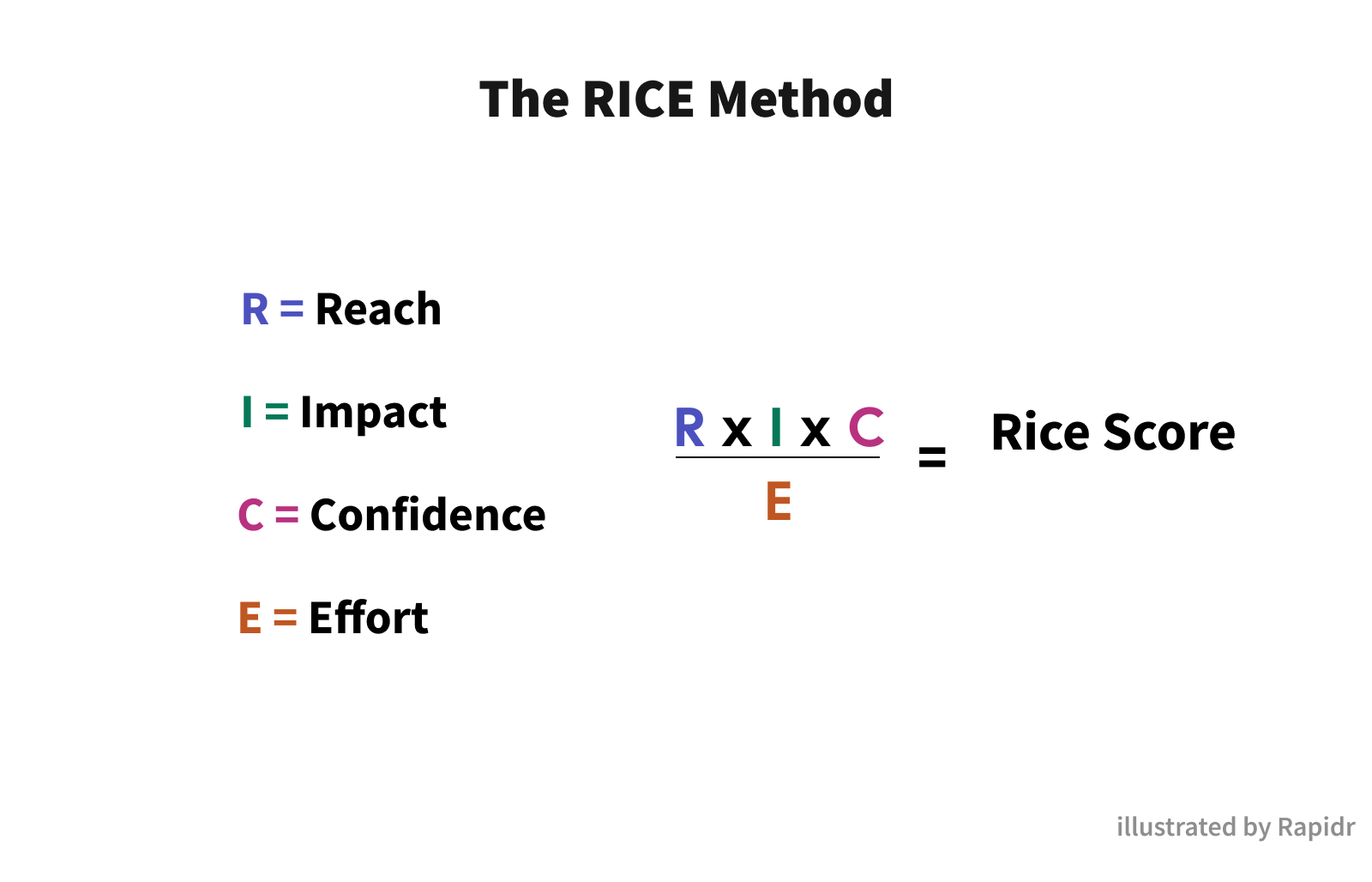
Pros of using the RICE method:
- Before you quantify your initiatives, you must convert the product metrics into SMART ones. This means your product metrics should be specific, measurable, attainable, relevant, and time-bound because RICE heavily relies on different metrics to be accurately evaluated.
- RICE method helps bring the entire team to a consensus since it requires estimation effort, impact analysis, etc., to be determined before development begins.
- It also helps you remove biases from your prioritization since the team puts each initiative under a microscope and evaluates objectively without speculations. Inherent bias by one team member doesn’t let the initiative get affected.
Cons of using the RICE method:
- Quite complex to calculate without specialized spreadsheets or software to facilitate the scoring.
- Assumes your product team is already using SMART metrics.
- This method has a learning curve, requiring you to explain and do trial runs with your team.
- Each developer has a different confidence level for doing a task, which can become quite burdensome.
- Hard to easily answer the question: “What should we build next?”
2. The Urgent vs. Important Matrix
It’s one of the most popular product prioritization strategies that help you decide on the real priority of each task.
Here, all you need to do is write down your product objectives, including the company's goals and what you need to do to achieve those objectives. You can update these objectives monthly, quarterly, or yearly.
Now, create a matrix and label the Y-axis as Important and the X-axis as Urgent. It should now consist of 4 quadrants that break down your tasks according to two parameters: level of urgency and importance.
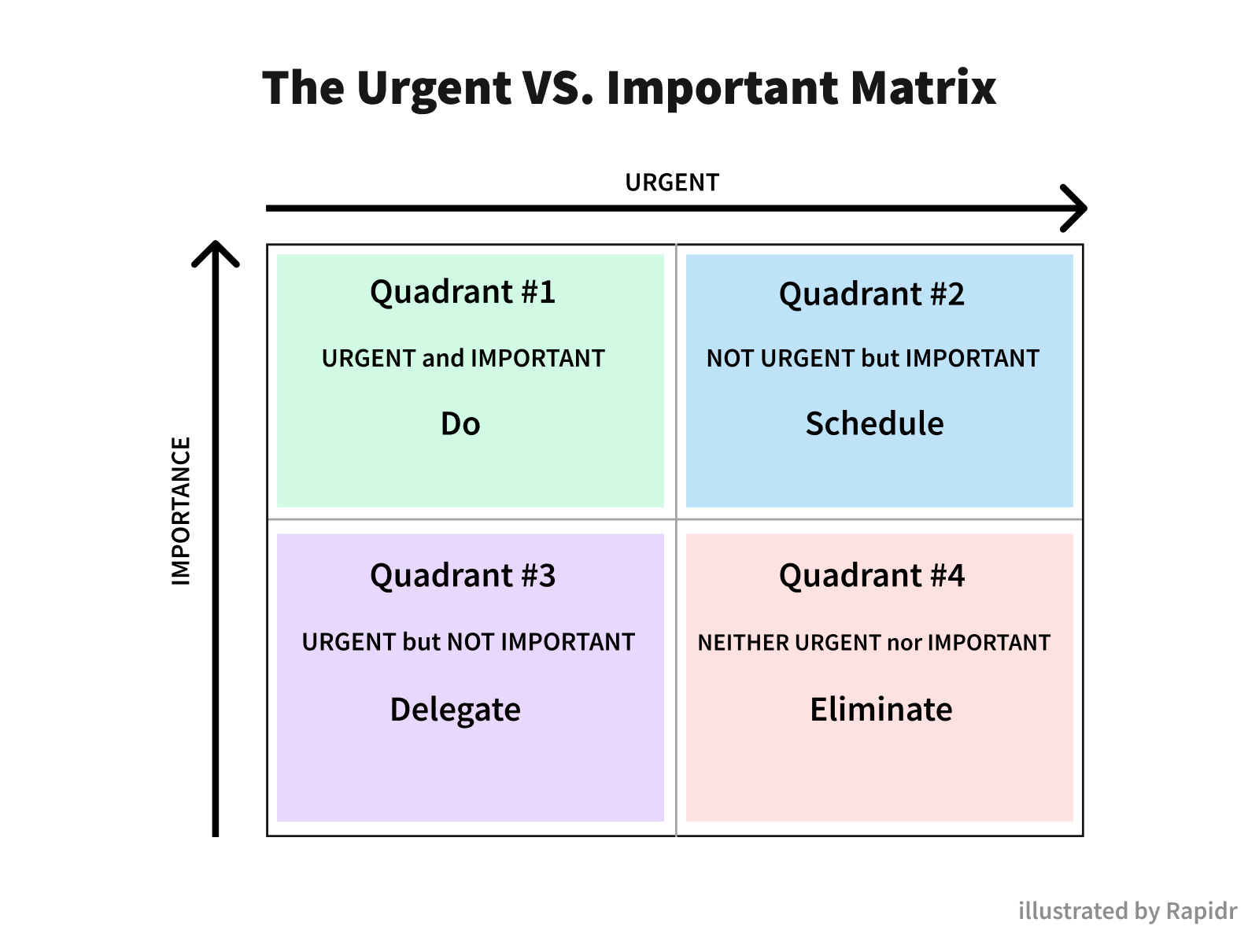
Quadrant #1 - Do
These pressing tasks need your team’s attention and time now. They’re both urgent and important. If certain tasks are grouped in this quadrant, they should be scheduled on your sprint.
Quadrant #2 - Schedule
These tasks are not urgent but very important to get done. For example, writing an email to get product feedback from a customer. It's not urgent; you can delay it inevitably, but it’s very important to get useful insights.
Quadrant #3 - Delegate
These tasks are urgent but not important enough for your team to do. Few tasks will ever fall into this quadrant but try to delegate as much as possible if they do.
Quadrant #4 - Eliminate
Busy work does not impact the company’s goals and/or your objectives. These tasks are neither important nor urgent; eliminate them from your backlog.
3. Value Vs. Effort matrix
Value versus effort is a product prioritizing model where you can ask your team to assign each feature with a value and a measure of effort. In this case, the value is the feature's revenue potential, and the measure of effort would be the amount of time it takes to achieve that feature.
Thanks to the value versus effort method, your team can identify which feature will impact your audience more and what it will cost the company. Moreover, combining this with the important/urgent feature prioritization matrix can reduce the risk of doing the grunt work.
A small downside to this method is that your team must thoroughly research a feature’s value. Some teams may underestimate a feature’s value, causing problems.
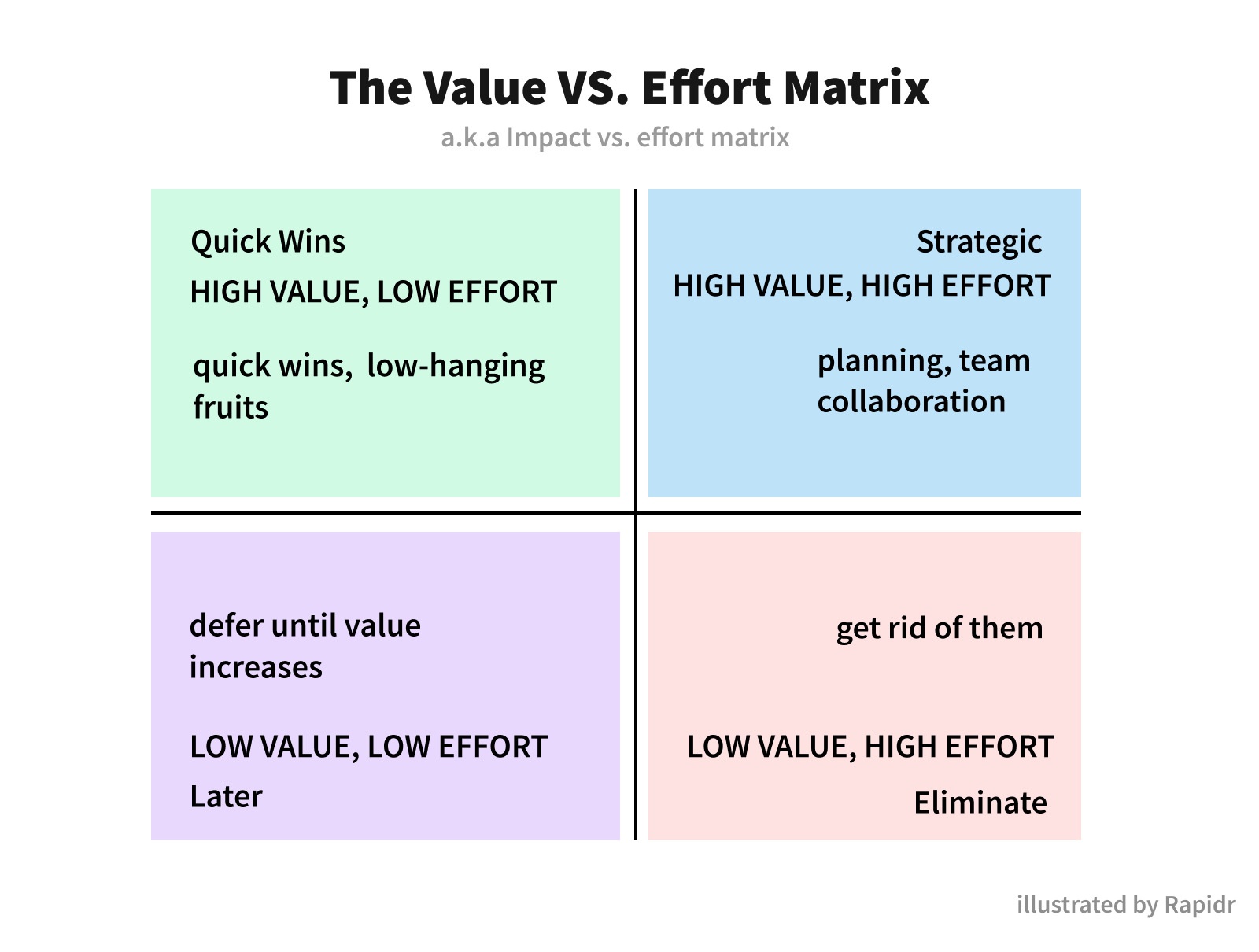
How to best measure value?
When considering value, you should run it through the mental model of how much it aligns with your business goals and objectives. How much value can it add to your customers? Here’s what you need to consider thoroughly:
Business value - Your business runs on KPIs and OKRs, and all your decisions should be based on how much value it drives to those objectives. For example, your business might have objectives like reducing churn, increasing the click-through rate, etc.
Customer value - Your customers are the biggest stakeholders in your business. You should consider their pain points and how far it goes to reduce them. Or have they requested this feature on your feature voting board?
How to best measure effort?
You try to measure the amount of effort required to perform this task. Most product teams try to use a “story point” based system, or the number of hours it will require is predecided by the team's collaboration during the start of the sprint. You must consider developer hours, costs of external services, and risks to external stakeholders.
Pros of using the Value vs Effort Matrix:
- Super intuitive to use and implement team-wide
- Extremely flexible without wasting a lot of hours
- Any product team can utilize it
- Clear prioritization can help you easily get buy-in from stakeholders.
Cons of using the Value vs Effort Matrix:
- Sometimes teams underestimate the effort required, which may lead to spillovers across sprints
- Harder to adopt in big organizations with large pipelines harder to adopt
4. Kano Model
The Kano model is another effective prioritization framework for your team. Overall, it prioritizes features based on their likelihood to delight customers.
The primary difference between this model and others is that this one uses a “Value vs. Satisfaction” graph. You view each potential feature through the lens of customer delight.
It’s a bit more complicated than the other prioritization methods, but it’s well worth it since it can help uncover some amazing insights when you’re stuck.
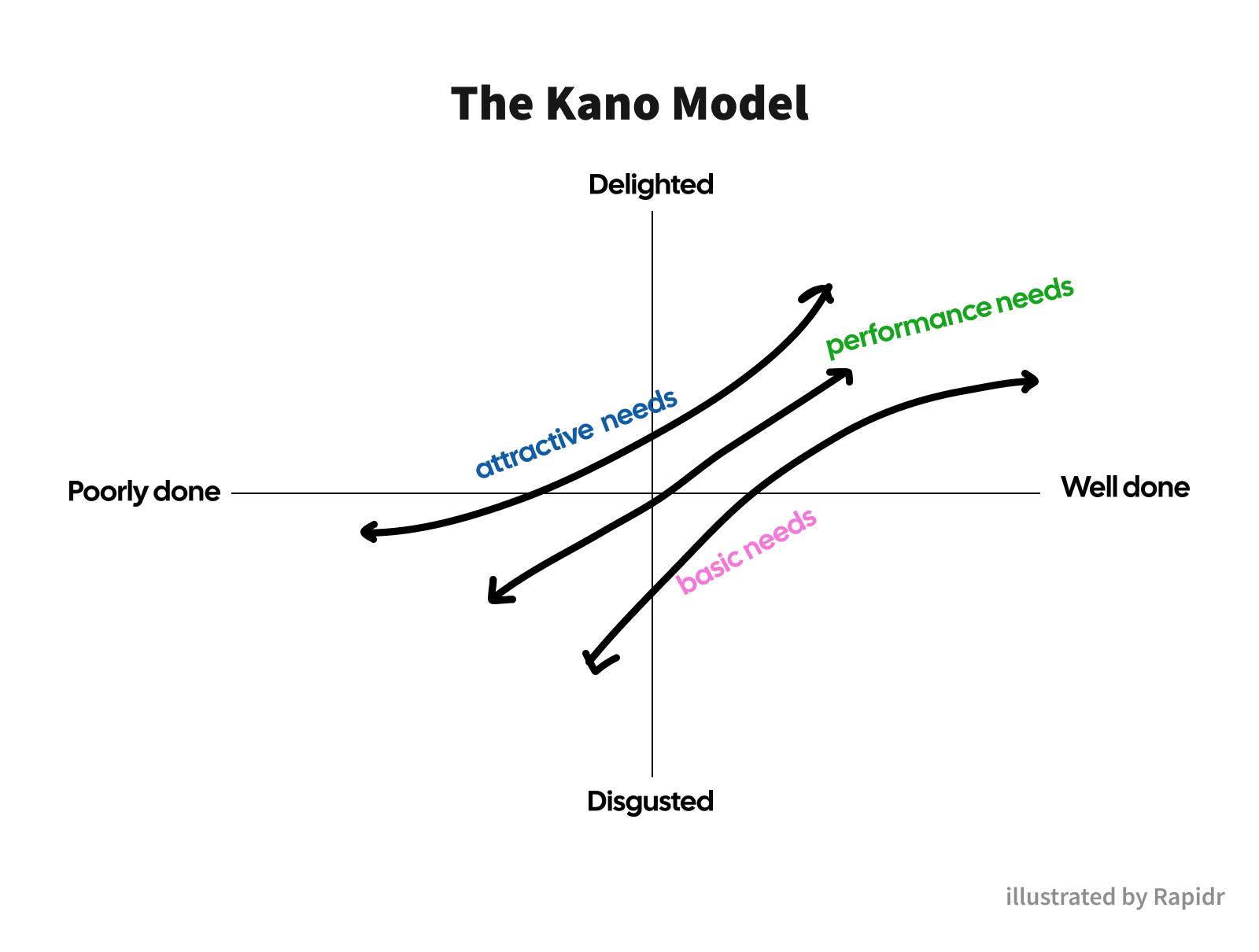
You can classify your product’s new features based on the following categories and emotional responses:
- Basic Features - The basic features are the foundation of your product, and they’re what the customer typically expects from it. Not having the foundation in place is dissatisfying. If you’re missing the key pieces in your product, schedule them as soon as possible.
- Attractive Features - These features trigger satisfaction and delight, but users are not dissatisfied if the feature is not included. These features fall more in what they don’t know they need yet bucket.
- Performance Features - These features result in delight when they’re present and dissatisfaction when not.
- Unattractive features - A few features can make your product super complex and overall undesirable. Avoid these at all costs.
The Kano model is one of the best ones you can implement since it’s simple to understand and implement.
5. Opportunity Scoring
You may know this model as ‘opportunity scoring’ or ‘opportunity analysis.’ Here, you will use a ‘Satisfaction’ and ‘Importance’ graph to measure your opportunities for a particular feature.
You can create a list of ideal outcomes for your product’s features and then ask for users' feedback. Once you’re done, you will end up with a list of the features that matter the most to your users but have low satisfaction scores.
The features with these ranks are the ones that you must prioritize. Opportunity scoring is a great way of identifying solutions to ongoing problems and may be easy for most people to use.
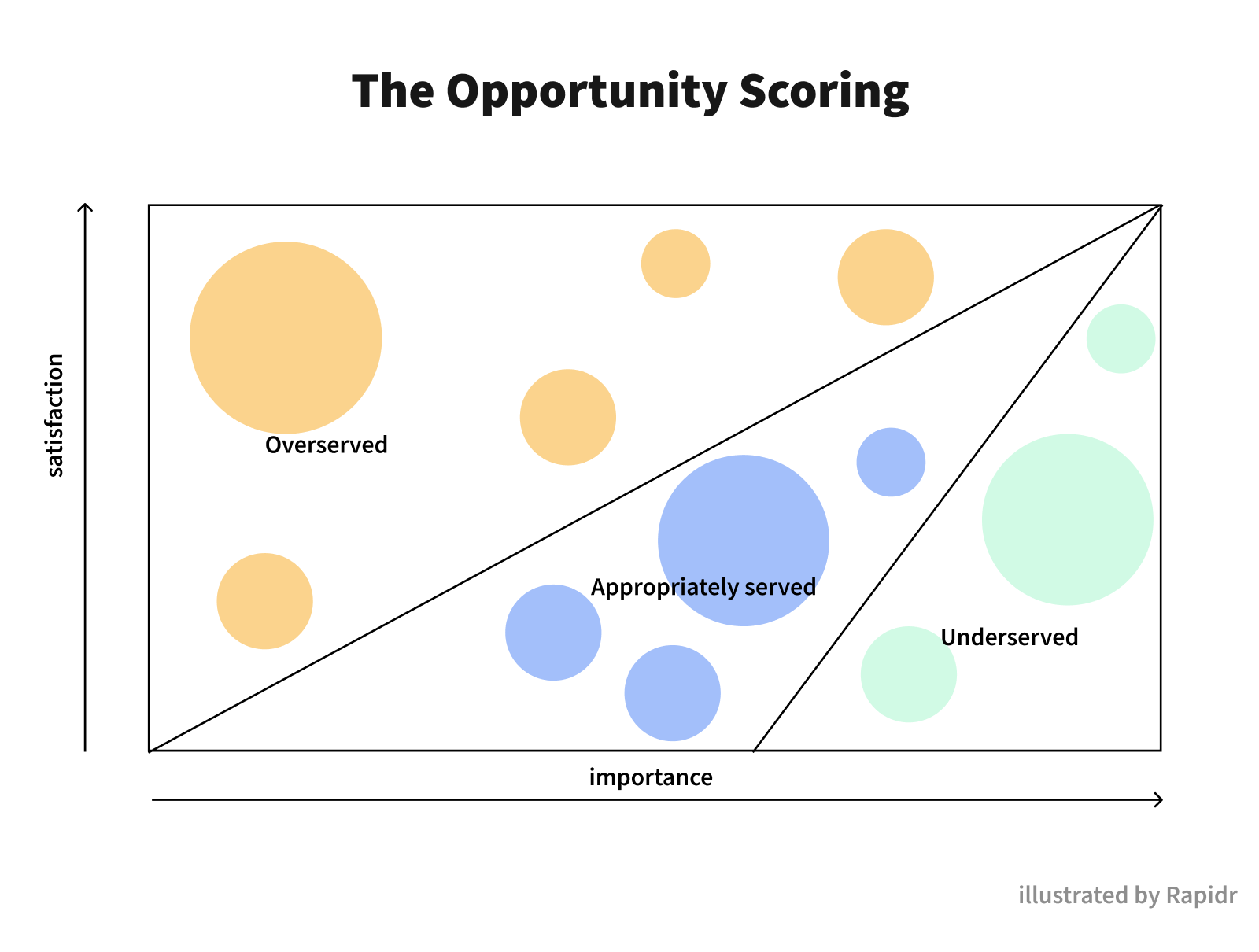
Opportunity mapping identifies and captures emerging business opportunities and clarifies where and how to allocate resources.
To implement this method, a business begins by identifying and assessing potential projects, providers, and ideas before implementing them, thus minimizing potential wasted resources.
6. Weighted Scoring
With weighted scoring, your team will numerically rank tasks, ideas, or projects. Overall, all you have to do is assign a number to score your ideas, rank them, and choose which features to prioritize based on the list you ended up with. Initiatives are scored and then ranked by their scores.
The weighted scoring method is perfect for companies who want an easier approach to prioritizing features since it’s easy to customize. Still, it’s important to note that the scores may be subjective to each team member’s ideas.
The overarching goal of this model is to derive an objective value for each item on the list. So you can then determine which items should be prioritized.
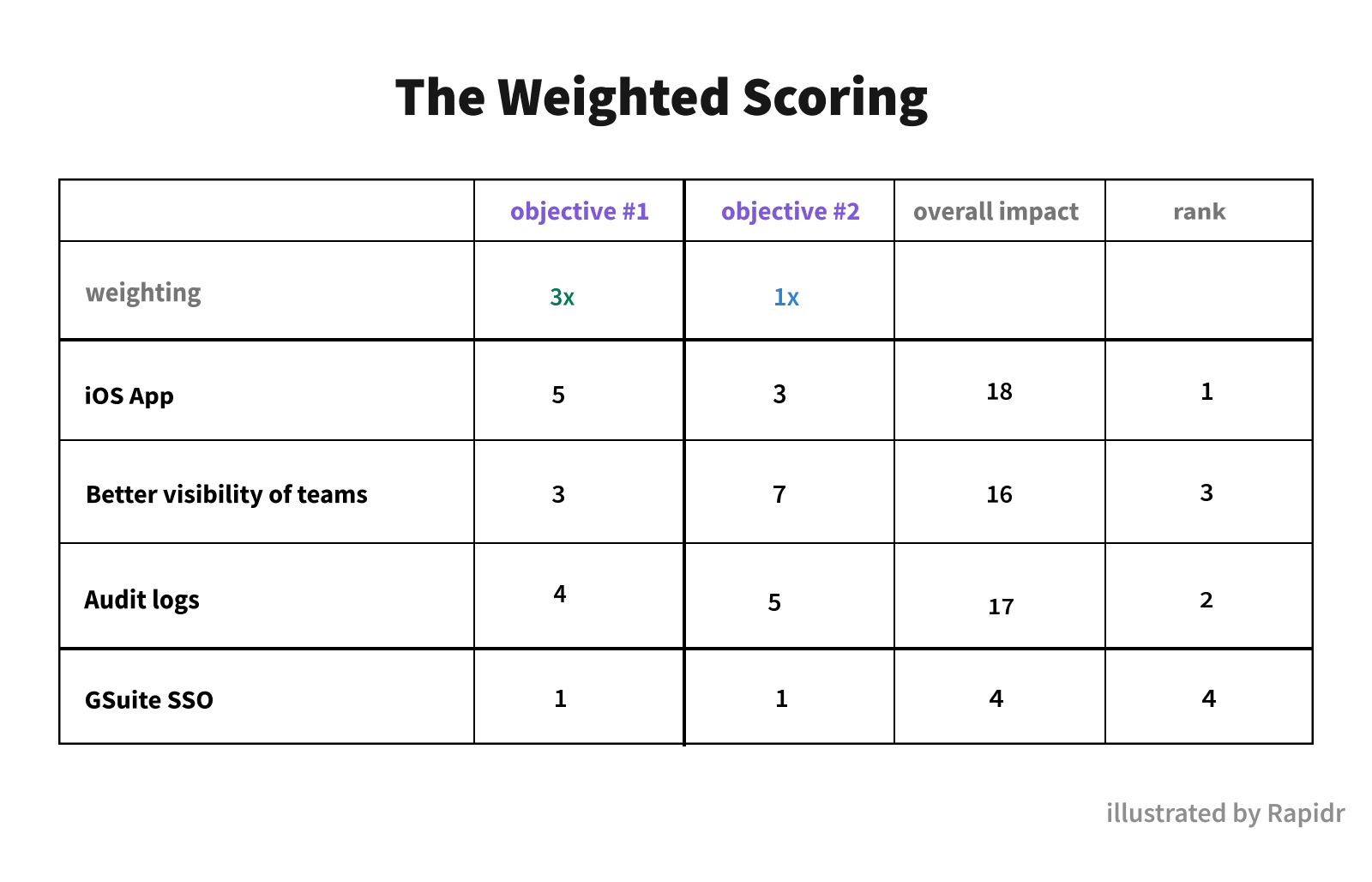
Pros of using Weighted Scoring:
- Easily align your initiatives to company objectives
- Different product teams can collaborate more effectively
Cons of using Weighted Scoring:
- Scoring can get biased. With this model, scoring may be biased
- Since the team assigns weights, it’s very subjective
- A tad harder to implement in bigger organizations
7. The MoSCow Method
Moscow stands for “Must-Have, Should-Have, Could-Have, and Won’t Have.” Generally speaking, this method allows you to classify your features into four priority themes, which are:
- Must-Have: Features must be present for the product to work.
- Should-Have: Features that aren’t necessarily urgent but are still important to get done.
- Could-Have: Features that aren’t urgent nor important but may still be a nice addition to the product.
- Won’t-Have: Features that aren’t necessary at the moment and may be considered for future releases.
The MoSCow method is highly dynamic, and it can help your team come up with a solution in a short period.

Pros of using MoSCoW method:
- Customer needs are always put on top
- Facilitates collaboration between team
- Highly intuitive since the premise is very straightforward
- Simple to implement in new product teams
Cons of using MoSCoW method:
- The pecking order starts from “must-have” and can cause spillage of “should-have” and “could-have.”
- Urgency is not accounted for in the order.
8. Product Tree
Bruce Hollman created this method, and it consists of shaping the product in a way that matches the customer outcomes that provide the highest value to the company.
In essence, you must draw a tree with big branches. The trunk of the tree represents the features of your product. On the other hand, the outermost branches represent future features, and the rest represent unavailable ones.
You can ask users to write some potential features they may want in your product, and these ideas will be represented as the tree’s leaves. This allows you to identify the most vital features to prioritize in a fun and more graphic way.

9. ICE Scoring
ICE stands for “Impact, Confidence, and Ease.”
You aim to assign a numerical score to your features based on their value according to these three parameters.
You may rank these features from one to 10 in each category and multiply those values together to get the features’ ICE score. In essence, “Impact” represents how much impact the feature will have according to the objectives. “Confidence” refers to the company's certainty that the feature will have the predicted impact.
Finally, “Ease” refers to how easy or complicated reaching the objective will be.
10. Feature Voting
Feature voting allows your customers (or team) to vote for the features they care about most. You can easily use a feature voting tool like Rapidr to create a roadmap, capture feature requests, and collect upvotes.
Rapidr helps you track features, ideas, and other suggestions on the customer feedback portal. It helps you manage the entire feedback lifecycle, from capturing feature requests to prioritizing features, informing the product roadmap, and sharing product updates with the release notes. Feature voting is enabled by default on your customer feedback portal and the feedback widget.
Rapidr also allows you to capture and track all user feedback and organize and analyze it in a centralized location in one single place. Then, inform your roadmap with the most critical feedback, notify users of what's new with release notes and close the feedback loop feature.
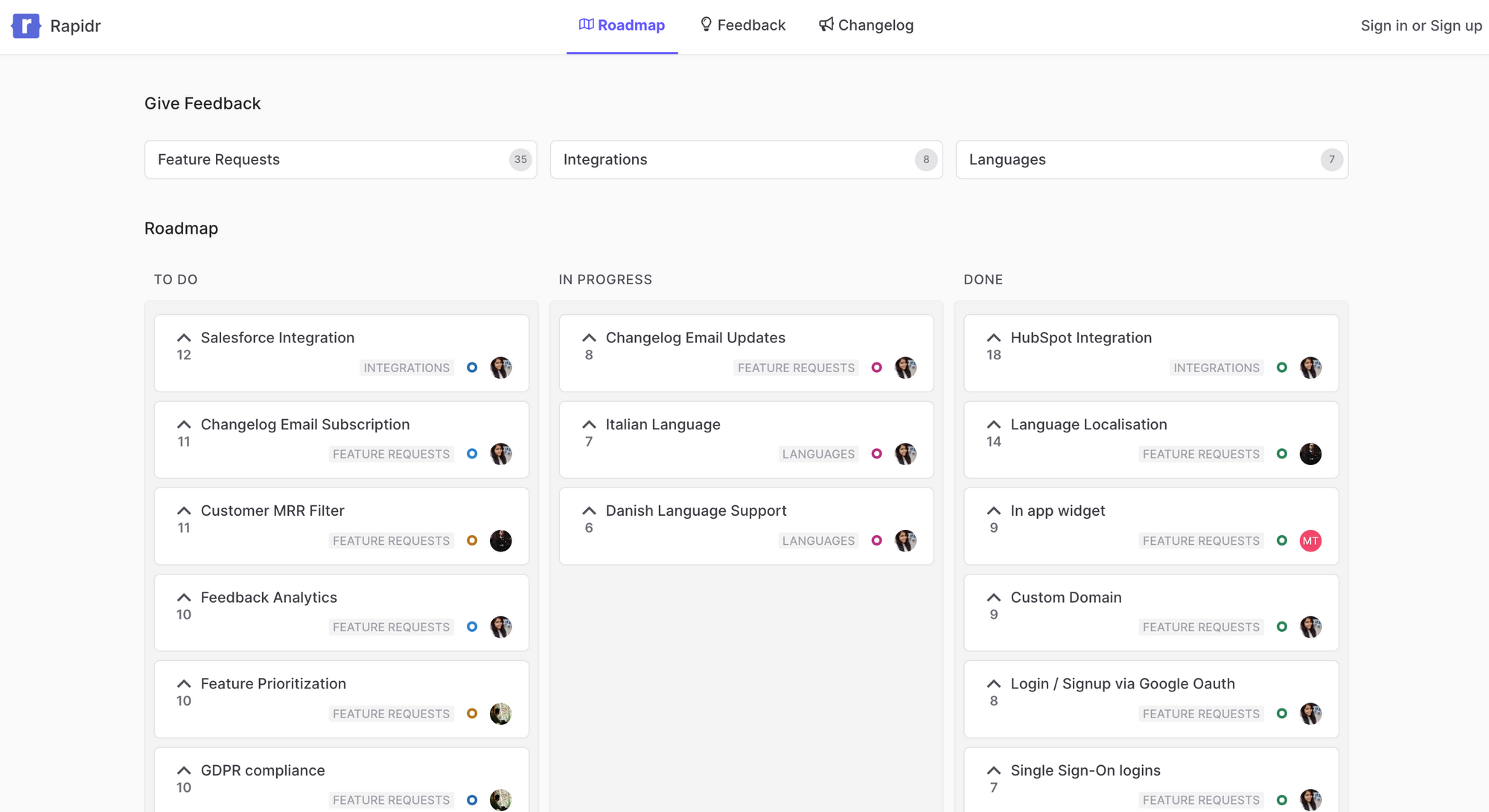
Pros of using Feature voting:
- Features that customers vote for will not consider wider aims like profitability, time to develop, etc.
- It’s easy to get your customers involved and make them feel valued.
Cons of using Feature voting:
- Reviewing the feedback can be quite time-consuming.
- For smaller businesses, it may result in low voter turnout.
11. Story Mapping
Story mapping is one of the most popular product feature prioritization models.
- Here, you’ll need to map out your product’s standard “usage” process for the user, such as signing up/purchasing, testing it, etc.
- Once you’re done with that process, you must write a detailed overview of all the steps a user must take in these stages.
- Finally, your team may review these tasks and arrange them in order of importance.
The best thing about the story mapping process is that it focuses on improving user experience rather than considering internal opinions. The story-mapping process often involves the entire development team and promotes teamwork.
Unfortunately, the story mapping method doesn’t consider factors like business value and complexity, which can disadvantage some. Story mapping enables product managers to shift their focus from their company to their customers.
- To start, you need to map out the typical stages of a user’s product journey, e.g., content search, signup, product search, trial, and customer churn.
- Then, write all the steps a user takes in each stage.
- Lastly, with the journey mapped out, you can go ahead and label a y-axis with “priority” and rearrange each step in order of perceived priority.

Pros of using Story mapping:
- Focuses on improving user experience rather than considering internal opinions.
- Easy to implement in your product team.
Cons of using Story mapping:
- Customer requests lead product prioritization initiatives.
- Mapping out the customer journey may be time-consuming.
How to Prioritize Product Features?
There’s always a ton of excitement when you start talking about things to build. New features are exciting. You can picture all the amazing places your product could go, the results it could bring, and the best-case scenario. But as a product manager, you must be the voice of reality.
As you go through and prioritize features in your product roadmap, remember that your overall strategy and product roadmap always need to be front and center. Don’t lose focus on the bigger picture with some exciting ideas. Long-term strategy always trumps short-term results.
Be conservative and live by the mantra of “less is more.” Big features can just as easily be risks if you don’t have the data and user research to back them up. Whenever possible, use Agile development practices to launch early and often.
Lastly, make time to regularly re-prioritize. Business needs change. Markets change. Leadership changes. And despite all the work you put into prioritizing features, those priorities will also change. Set aside time to review your list and ensure everything is aligned with the bigger picture.
The prioritization process is an ongoing one. It’s a never-ending cycle of asking, “What’s the most important thing we can be working on right now to solve this problem?”
Prioritize Features & Manage Feedback With Rapidr
The problem with prioritizing features is that too many moving pieces aim to capture and solve the most impactful customer problems. That’s where an end-to-end customer feedback tool like Rapidr can help. Using Rapidr, you can:
- Capture and manage customer feedback in one organized place.
- Analyze and prioritize product feedback validated by the customers.
- Commit to feature requests and ideas by promoting them to your product roadmaps.
- Close the feedback loop by notifying all stakeholders about feature releases with release notes/changelog.
Rapidr helps SaaS companies set up a dedicated place to track different types of customer feedback, understand what customers need, and prioritize what to build next. Sign up to get started.

